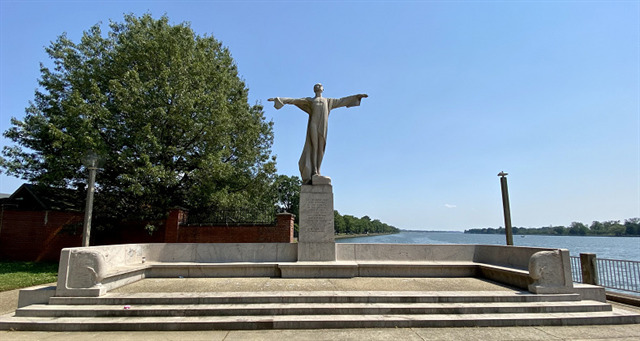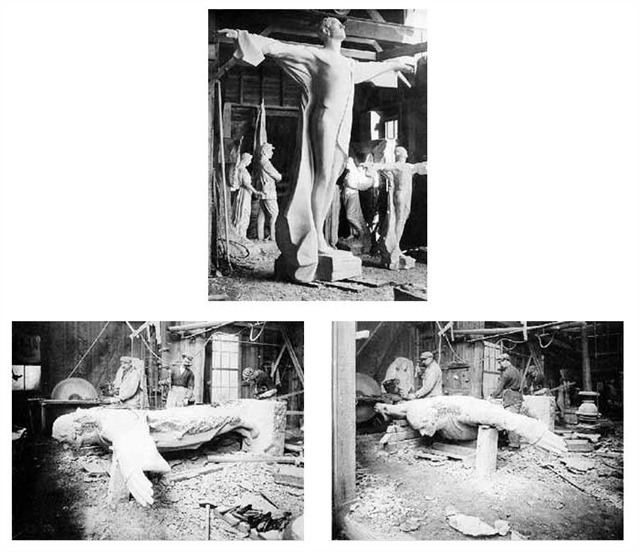This is an Earthcache – as such, there is no physical cache. Instead, you will partake in a geology lesson. Read the cache description and make observations at the Titanic Memorial. Complete the listed logging requirements to get credit for this cache. Permission to place this Earthcache was granted by the National Park Service.
TITANIC MEMORIAL

The Titanic Memorial is a granite statue that honors the men who gave their lives so that women and children might be saved during the RMS Titanic disaster. The thirteen-foot-tall statue is of a partly clad male figure with arms outstretched standing on a square base. The base is flanked by a square exedra that encloses a small raised platform.
The memorial sits along the Anacostia Riverwalk Trail in Washington Channel Park next to Fort Lesley J. McNair. The statue was sculpted by John Horrigan from a single piece of red granite. The red granite (or Westerly Granite) was furnished from Westerly, RI, by the Henry C. Smalley Granite Company.
The sculpture itself vaguely resembles the scene from the 1997 Blockbuster film when Leonardo DiCaprio and Kate Winslet stand on the bow of the Titanic with arms outstretched. On the day the monument was originally dedicated, Former First Lady Nellie Taft unveiled the memorial and introduced its artist, Gertrude Vanderbilt Whitney. A few years later, the Great Potomac Flood of 1936 inundated and damaged the memorial (how ironic). Originally located at the foot of New Hampshire Avenue NW in Rock Creek Park along the Potomac River, the monument was removed in 1966 and placed into temporary storage to accommodate the Kennedy Center. In 1968, the memorial was re-erected without ceremony at its current location.
 The carving of the thirteen-foot high statue was done by John Horrigan in Quincy, MA. The red granite for the statue was furnished from Westerly, RI, by the Henry C. Smalley Granite Company. Mr. Horrigan is seen here working near the right shoulder of the sculpture.
The carving of the thirteen-foot high statue was done by John Horrigan in Quincy, MA. The red granite for the statue was furnished from Westerly, RI, by the Henry C. Smalley Granite Company. Mr. Horrigan is seen here working near the right shoulder of the sculpture.
GRANITE
Granite is an intrusive igneous rock that begins as a molten liquid state that solidifies as it cools. It forms from magma with a high content of silica and alkali metal oxides that slowly cools and solidifies underground. The texture of granite is determined by the rate in which it cools. The large mineral crystals in granite are evidence that it cooled slowly from molten rock. This mineral composition usually gives granite either a red or pink (more feldspar and less quartz) to gray or white (more quartz and less feldspar) color with additional mineral crystals visible throughout the rock. Granite is hard enough to resist most abrasion, strong enough to bear significant weight, and inert enough to resist weathering. Granite is a coarse-grained (phaneritic) rock composed mostly of quartz, alkali feldspar, and plagioclase.

"RED WESTERLY" GRANITE
"Red Westerly" Granite is a biotite granite of reddish-gray color speckled with black and of even-grained medium, inclining to coarse texture, with feldspars under 0.4 inch, exceptionally 0.5 inch, and mica up to 0.2 inch long. Its constituents, in descending order of abundance are: Reddish potash feldspar (microcline and orthoclase-albite); and black mica. Both feldspars are in places stained red from hematite, resulting from the oxidation of magnetite particles, which with pyrite is among its accessory minerals. Secondary calcite is also present.
Westerly Granite is mid-Early Permian in age, and dates back 279 million years (Sakmarian Stage OR Artinskian Stage, depending on what geologic time scale one uses).
TYPES OF WEATHERING
There are two distinct types of weathering which alter and degrade rocks in different ways. Physical Weathering breaks down a rock's physical structure. For example, in cold environments water that gets into holes in rock and freezes will cause those holes to expand and eventually crack and split the rock. The same process may be caused by salt buildup or growing tree roots. Another form of physical weathering occurs when wind or water causes rocks to rub against each other, smoothing their surfaces. One of the most common types of physical weathering is wedging. Wedging occurs when a substance finds its way into cracks or holes in a rock and expands outward. This widens these cracks and holes, and can cause rock to split apart; this may also occur to exposed brick. Freezing water, crystalizing salt, and growing plant roots are common causes of wedging.
Chemical Weathering changes the chemical structure of rock, causing it to become softer or more brittle. For example, iron in a rock might react with oxygen to form easily degradable rust, or acids in rainwater may remove calcium from limestone and marble. Chemical weathering often precedes physical weathering, making rocks more vulnerable to forces like wind and rain. Chemical weathering does not cause physical damage to rock but rather is a reaction between the chemical composition of the rock and outside chemicals. Chemical weathering can make a rock more vulnerable to physical weathering forces. For instance, oxidation is a process by which oxygen in the air reacts to chemicals in the rock. Iron in rocks can react with oxygen to form iron oxide, or rust. Rust is weaker than iron and makes the rock more likely to degrade. Hydration is a reaction in which molecules of water are incorporated into the structure of a rock. For instance, hydration causes the mineral anhydrate to convert into gypsum, a less dense mineral that is more vulnerable to outside physical weathering forces.
REFERENCES:
1. Pink Westerly Granite, Granites & Porphyritic Granites, jsgeology.com
2. DC Titanic Memorial: Silent Tribute in Southwest, Hayley Samela and Matt Rist, nbcwashington.com
3. Titanic Memorial (Washington, D.C.), wikipedia.com
4. Granite, wikipedia.com
5. Commercial Granites of Massachusetts, New Hampshire, and Rhode Island, T. Nelson Dale, Department of the Interior, Bulletin 354, pages 191-192, 1908, books.google.com
6. The Difference Between Weathering and Erosion, Jon Zamboni, sciencing.com
LOGGING REQUIREMENTS:
To log this Earthcache: Read the geology lesson above. Go to the posted coordinates and make your observations. Answer the four (4) questions below and post a photo. Answers can be sent via e-mail or instant messenger on my Geocaching profile. Do not post the answers to the questions in your logs.
QUESTION 1. What determines the texture of granite?
QUESTION 2. The "Red Westerly" Granite used to sculpt the Titanic Memorial is slightly reddish in color. (A) What is the mineral composition of this granite? (B) Describe the reason for its color.
QUESTION 3. Touch the granite and describe its texture.
A) Pegmatitic - A pegmatitic texture is one in which the rocks crystals are about 1” long to larger.
B) Phaneritic - A phaneritic texture has crystal grains large enough to be distinguished with the eye.
C) Aphanitic - An Aphanitic texture consists of extremely small crystals.
QUESTION 4. Do you see any signs of weathering? If so, describe in detail. If not, what do you think the reason for this is?
POST A PHOTO. Post a photo that readily indicates that you (and anyone else logging the find) are at the location. You do not have to show your face, but the photo should be personalized by you or by the use of a personal item. Your background should include a view of the Titanic Memorial. NOTE: Per newly published Earthcache guidelines, this is REQUIRED to claim the find.

